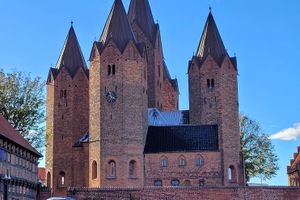Most churches have one or two towers. The Church of Our Lady in Kalundborg, Denmark, has five. Built in the late 12th century, this red-brick Romanesque church was designed as a perfect Greek cross, with a tower rising from each arm and a fifth at the center. The layout is strikingly balanced, a rare architectural gesture in medieval Europe.
Seen from the fjord, the five towers rise above the hilltop town like a fortress-like crown. Their deliberate symmetry has long invited symbolic interpretations: the central tower as Christ, the four others as the evangelists. From a distance, the sight is so harmonious it feels almost mathematical.
Local legend, however, offers a very different explanation. The church, it’s said, was built by a troll who struck a deal with Esbern Snare, the founder of Kalundborg. In exchange for his labor, the troll demanded Snare’s eyes and soul, unless Snare could guess the troll’s name before the final stone was laid.
As the story goes, Snare later overheard the troll’s wife singing a lullaby to their child and learned the name: Finn. When the last stone was placed, Snare spoke it aloud, breaking the bargain.
Enraged at being outwitted, Finn tried to tear the church apart before vanishing underground. When part of the building collapsed in 1827, engineers blamed age and shifting masonry. Locals preferred another explanation: that Finn had finally returned to finish what he started.
